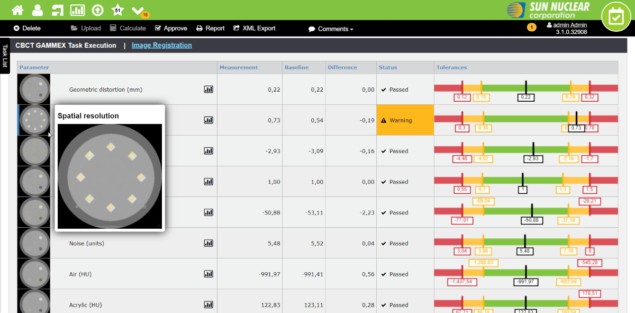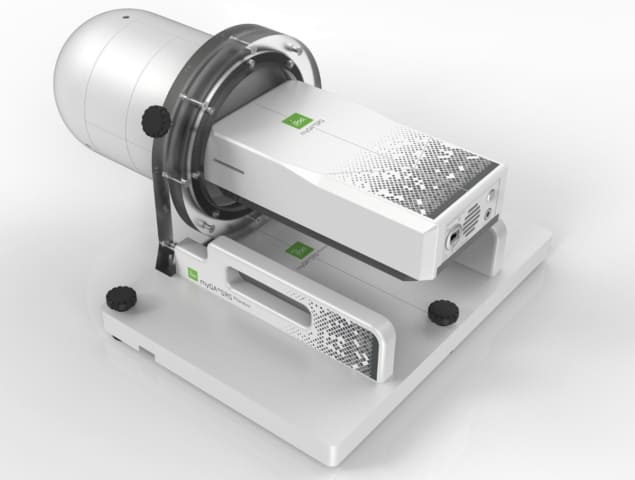ASTRO convenes in-person conference for the cancer care community
24 Oct 2021 Sponsored by Physics World corporate partners
Clinicians, researchers and healthcare professionals will be able to reconnect at the annual meeting of American Society for Radiation Oncology, which will be held as an in-person event in Chicago, Illinois

The American Society for Radiation Oncology (ASTRO) will once again welcome delegates to its annual meeting, which is due to take place in Chicago, IL, on 24–27 October 2021. Thousands of oncologists, clinicians, researchers and healthcare professionals are expected to come together to share knowledge and experience, and to reconnect with colleagues and friends at an in-person event.
“The ASTRO Annual Meeting will be the first major medical conference held in Chicago since the start of the COVID-19 pandemic,” said ASTRO president Laura A Dawson. “We are working closely with the city of Chicago and local planners to ensure that safety protocols are in place to foster a healthy, safe and engaging learning experience for attendees.”
Those unable to attend in person can still access all the presentations through ASTRO Digital XP, a virtual meeting platform that includes live interactive sessions, recorded presentations and Q&A from the live meeting, plus additional original programming that will feature a keynote presentation as well as extra scientific sessions. All the content on Digital XP will be available to view until 30 November.
The theme for the meeting will be “Embracing change, advancing person-centred care”, with the Presidential Symposium focusing on how to exploit rapid advancements in the field to provide the best patient care in the most efficient ways. Around this theme, some 1500 scientific presentations highlighting new results from clinical trials and other research studies will be presented, alongside educational panels, keynote addresses and other special sessions.
More than 160 exhibitors will also make their way to Chicago’s McCormick Place to showcase their latest technologies for cancer care. Attendees will be able to network with industry partners, view product demonstrations, and ask questions about new products and trends on the horizon. Some of the latest innovations are highlighted below.
Motion phantom delivers end-to-end quality assurance
The QUASAR Respiratory Motion Phantom (pRESP) from Modus QA is a programmable breathing and tumour 3D motion simulator that enables end-to-end quality assurance (QA) on motion-guided radiation therapy systems such as CT, LINAC and PET.
The phantom makes it easy to adjust the motion frequency and amplitude in real time using a local manual control at the motor, while more complex patient-specific waveforms can be created, imported and played back with the advanced programmable motion software. The QUASAR Respiratory Motion Phantom from Modus QA combines simple design with comprehensive testing capabilities. (Courtesy: Modus QA)
The QUASAR Respiratory Motion Phantom from Modus QA combines simple design with comprehensive testing capabilities. (Courtesy: Modus QA)
 The QUASAR Respiratory Motion Phantom from Modus QA combines simple design with comprehensive testing capabilities. (Courtesy: Modus QA)
The QUASAR Respiratory Motion Phantom from Modus QA combines simple design with comprehensive testing capabilities. (Courtesy: Modus QA)Versatile and interchangeable inserts are available for imaging, planning, targeting, dosimetry and delivery QA. The pRESP also features a vertical chest-wall surrogate that is compatible with various third-party tracking systems for motion-guided radiotherapy.
With more than 1100 units in use worldwide, Modus says that the QUASAR pRESP is a proven motion QA solution that has solidified its reputation as a trusted, efficient and cost-effective tool for respiratory motion management.
SRS phantom enables fast and accurate measurement of multiple lesions
The NavPhan phantom has been optimized for testing and commissioning systems for stereotactic radiosurgery (SRS) and the novel technique of single-isocentre multi-target (SIMT) SRS, which enables multiple lesions to be treated more rapidly. The phantom enables accurate end-to-end testing, QA for image-guided radiotherapy with six degrees-of-freedom, and patient-specific measurements in a single device. NavPhan is the first product to be launched by NavAxis, a medical device start-up specializing in radiation oncology QA. The NavPhan phantom from medical device start-up NavAxis enables multiple lesions to be measured quickly and accurately. (Courtesy: NavAxis)
The NavPhan phantom from medical device start-up NavAxis enables multiple lesions to be measured quickly and accurately. (Courtesy: NavAxis)
 The NavPhan phantom from medical device start-up NavAxis enables multiple lesions to be measured quickly and accurately. (Courtesy: NavAxis)
The NavPhan phantom from medical device start-up NavAxis enables multiple lesions to be measured quickly and accurately. (Courtesy: NavAxis)NavPhan’s patented design allows the user to measure any distribution of targets directly using full composite delivery. The workflow allows accurate measurement of the dose for the smallest of targets, whether they are on- or off-axis. Since three targets are guaranteed to be measured per delivery, the system is three times more efficient during measurement than other planar devices.
The NavPhan can achieve a set-up accuracy of less than 0.2 mm and below 0.1° both in terms of dose plane extraction and during the measurement. Exactly aligning the measurement plane with the one extracted from the dose distribution eliminates a common source of error in small-field QA that can often require the measurements to be taken again.
Phantom offers end-to-end verification for stereotactic treatments
Stereotactic radiosurgery requires a high degree of accuracy in both target localization and dose delivery. Small errors can result in significant undertreatment of regions within the tumour volume, or overdose of nearby healthy tissues.
The Stereotactic End-to-End Verification Phantom (STEEV) from CIRS offers a way to check all the necessary steps of a treatment planning system – from diagnostic imaging with CT, MR and PET, to verification of the treatment plan. STEEV’s anthropomorphic exterior allows multiple positioning and fixation devices to be used, while internal details such as cortical and trabecular bone, brain, spinal cord, teeth, sinuses and trachea provide the most realistic clinical simulation for different anatomies. The STEEV phantom from CIRS comes with a range of geometric and organic inserts to enable comprehensive testing for stereotactic radiosurgery. (Courtesy: CIRS)
The STEEV phantom from CIRS comes with a range of geometric and organic inserts to enable comprehensive testing for stereotactic radiosurgery. (Courtesy: CIRS)
 The STEEV phantom from CIRS comes with a range of geometric and organic inserts to enable comprehensive testing for stereotactic radiosurgery. (Courtesy: CIRS)
The STEEV phantom from CIRS comes with a range of geometric and organic inserts to enable comprehensive testing for stereotactic radiosurgery. (Courtesy: CIRS)Geometric and organic target inserts offer comprehensive testing for different imaging modalities as well as machine QA and treatment planning. These include a variety of interchangeable tissue equivalent inserts that are suitable for small-field dosimetry, enabling dose measurements at both isocentre and off-isocentre positions.
Sun Nuclear highlights integrated and independent QA solutions
With the ever-increasing demands on the resources available for radiation therapy, both independence and integration are needed for effective quality management. During ASTRO’s Annual Meeting, Sun Nuclear will feature its leading quality management solutions in exhibitor booth #1029, with daily demonstrations and in-booth talks from clinical users.
Talks on automated workflows will discuss the use of SunCHECK – a single scalable platform for standardizing, integrating and automating both machine and patient QA. These include:
Comparison of Vendor-Dependent versus Commercially-Available, Independent Linac Quality Assurance (QA) featuring SunCHECK Machine Presenter: Cassandra Stambaugh, Tufts Medical Center, Boston, US
Automating and Standardizing QA Workflows with SunCHECK Platform Presenter: Mark Geurts, Aspirus Health, Wausau, US The SunCHECK platform enables tasks and templates for machine QA to be standardized across users, sites and machines. (Courtesy: Sun Nuclear)
The SunCHECK platform enables tasks and templates for machine QA to be standardized across users, sites and machines. (Courtesy: Sun Nuclear)
 The SunCHECK platform enables tasks and templates for machine QA to be standardized across users, sites and machines. (Courtesy: Sun Nuclear)
The SunCHECK platform enables tasks and templates for machine QA to be standardized across users, sites and machines. (Courtesy: Sun Nuclear)Another presentation will offer an insight into building a strong end-to-end stereotactic programme using SRS MapCHECK, Sun Nuclear’s film-less array for patient QA.
Single Isocenter Multi-met SRS: Planning, Delivery and QA Presenter: Justin Roper, Winship Cancer Institute of Emory University, Atlanta, US
SRS MapCHECK now includes CyberKnife machine QA, making it the only device that offers both machine QA and patient QA on a CyberKnife.
To learn about these solutions and more, visit sunnuclear.com.
Digital QA solution by IBA Dosimetry delivers speed and film-class resolution for stereotactic treatments
IBA Dosimetry will be showcasing its fully digital solution for high-resolution QA for both stereotactic radiosurgery (SRS) and stereotactic body radiation therapy (SBRT). The myQA SRS system features a digital detector array for faster QA, and also achieves a film-class resolution of 0.4 mm. With an active detector area measuring 12×14 cm2, the solution offers more than 100,000 measurement pixels to avoid the need for interpolation.
“The digital detector QA workflow with myQA SRS is 106 times faster and easier compared to using film,” comments Yun Yang of Rhode Island Hospital, who has tested the solution in a clinical setting. “The film-equivalent resolution for our QA measurements is the basis for better and more meaningful SRS patient plan verification with a high sensitivity and specificity to detect the real dose errors.” Yang presented his results in a poster during the AAPM 2021 Annual Meeting, as well as in a webinar that is available on the IBA Dosimetry website. The myQA SRS solution from IBA Dosimetry delivers fast and precise patient-specific QA for stereotactic treatments. (Courtesy: IBA Dosimetry)
The myQA SRS solution from IBA Dosimetry delivers fast and precise patient-specific QA for stereotactic treatments. (Courtesy: IBA Dosimetry)
 The myQA SRS solution from IBA Dosimetry delivers fast and precise patient-specific QA for stereotactic treatments. (Courtesy: IBA Dosimetry)
The myQA SRS solution from IBA Dosimetry delivers fast and precise patient-specific QA for stereotactic treatments. (Courtesy: IBA Dosimetry)IBA Dosimetry will also be introducing myQA iON, a software environment that combines all patient QA tasks and workflow steps in a single interface. The software allows irradiation log files and dose measurements to be used alongside Monte Carlo prediction techniques, allowing the dose profile to be recalculated with fewer measurements and greater accuracy.
fromphysicsworld.com 24/10/2021
Δεν υπάρχουν σχόλια:
Δημοσίευση σχολίου